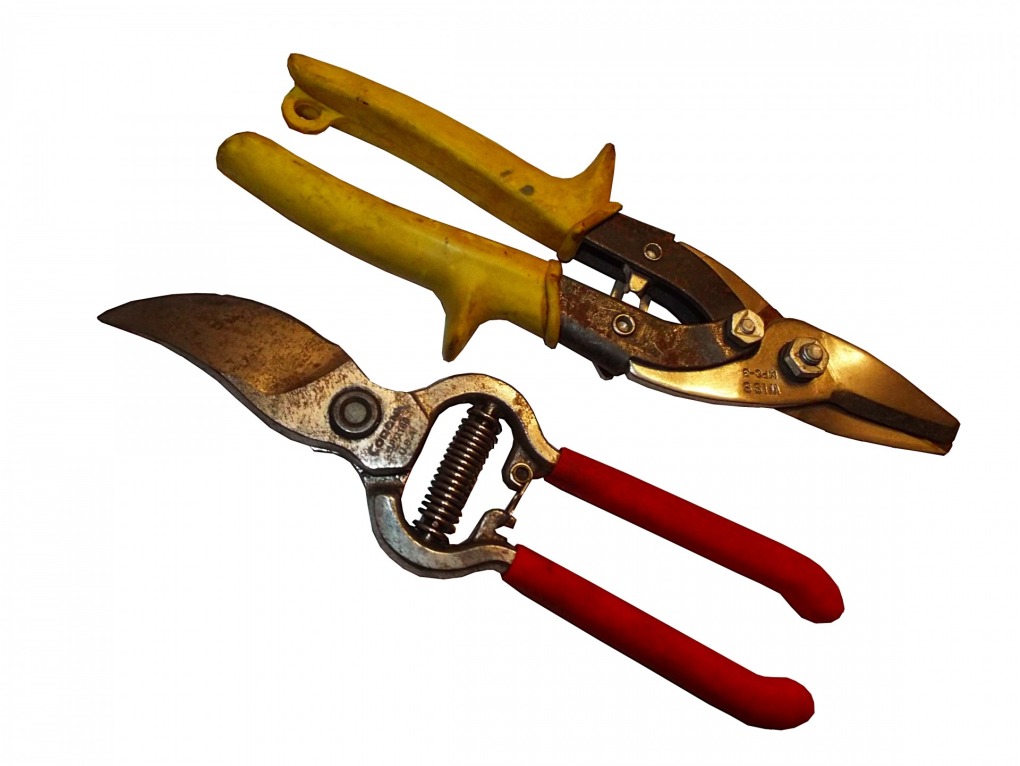The list is short.
The list is short: secateurs (single-hand pruners), loppers, two-handed pruners, a Japanese pruning saw, a pole pruner, and a ladder. I recommend you buy the best you can; they will last a lifetime, be efficient and durable, cut well, and stay sharp because they are made from better steel. They also make the healthiest cuts.
First, a word about two types of pruners:
Bypass vs. anvil pruners
Felco and other high quality pruners are called bypass pruners, which means that when the two-handled tool is squeezed shut to make a cut, the blade passes over the anvil. This allows you to get in very close and make quality cuts. The other type, called anvil pruners have the blade sitting in the middle of a groove in the anvil when closed. The width of the anvil itself inhibits getting in really close. One other problem with anvil pruners is that they tend to crush as much as cut. This can leave ragged and torn bark at the edge of your cuts. Tsk, tsk. All the hand tools that I use—secateurs, loppers, and my pole pruner—are bypass pruners.
Now, let’s discuss these essential tools one at a time.
Secateurs
Secateurs, a French name for hand clippers, has a nice ring to it, and harks back to the long history of pruning vineyards and creating espalier. Felco is the one brand I have used for my whole life. The Felco 2 is the world standard. There are other brands, but Felcos are pretty much bomb-proof, easy to use, comfortable, stay sharp, and all parts are replaceable. They also come in a variety of models for every hand.
Loppers
Loppers are extra-large sized secateurs operated with two hands. With bigger blades and long handles—in some models, nearly three feet—they give you the leverage you need to make big cuts. Braced down on your knees with a hand firmly on each handle, you are in a power position. When I say down on your knees, this describes shrub rejuvenation work. I do not use loppers to prune trees. Loppers are the best tool for shrub work. If you are cutting larger tree branches, use a pruning saw.
Pruning saws
There are many types of pruning saws. I recommend one from Japan, or at least using the Japanese pattern. There are two major modifications that the Japanese brought to the traditional triangle-shaped sawtooth pattern of antiquity.
Firstly, they turned all the teeth slightly backwards. In a traditional tooth pattern, the teeth of the saw point straight down. The Japanese pattern leans all the teeth backwards slightly towards the handle. This subtle change allows for the best control, because the saw is made to cut on the pull stroke. Placed on a branch, the saw is made to cut when you pull the handle towards you rather than push it away from you. You stay in better control and in your strength zone.
The second modification was the creation of a third bevel, a third cutting edge at the tip of the tooth. The traditional saw’s triangular tooth has two bevels, one on each side of the tooth. The Japanese insight was to create another bevel by cutting the tip of the tooth off, leaving behind another sharp cutting bevel.
Almost all working arborists use Japanese pruning saws for their work and I recommend you do the same. The brand I prefer is Silky. You get what you pay for.
Pole pruners
When the cuts you want to make are too high to reach, use a pole pruner. A pole pruner is a slightly different configuration of a bypass tool. Mounted on the end of a wooden or fibreglass pole, this tool is operated by pulling on a rope attached to the blade, allowing it to bypass the anvil mounted on the pole.
More difficult to use than the other tools previously described, it is still an essential tool. Again, quality makes all the difference. Many cheaply-made, floppy tools that wouldn’t last the day in my hands are readily available from the garden centre and home improvement megastore. Do not buy these; they don’t perform well, they are too expensive, and they fall apart. For the same or less money you can buy a professional-grade tool that is a pleasure to use compared to the cheap knockoff.
Marvin is a high quality brand. Check it out at bigbeartools.com. This quality seller near Vancouver is where I buy all my tools.
Ladders
Lastly, we have our ladder. Buy a good brand of sturdy four-foot wooden ladder. People think that since you’re working on trees, you need tens of feet of ladder. Not so. A four-foot allows you to work under your tree, where a six- or eight- foot wouldn’t fit.
I use the four-foot for taller shrub work as well. It is amazing how many times you just need to be one or two feet higher. Work where you are comfortable; don’t over-stretch. The four-foot Sturdy I use is strong enough that I stand on top of it all the time.









